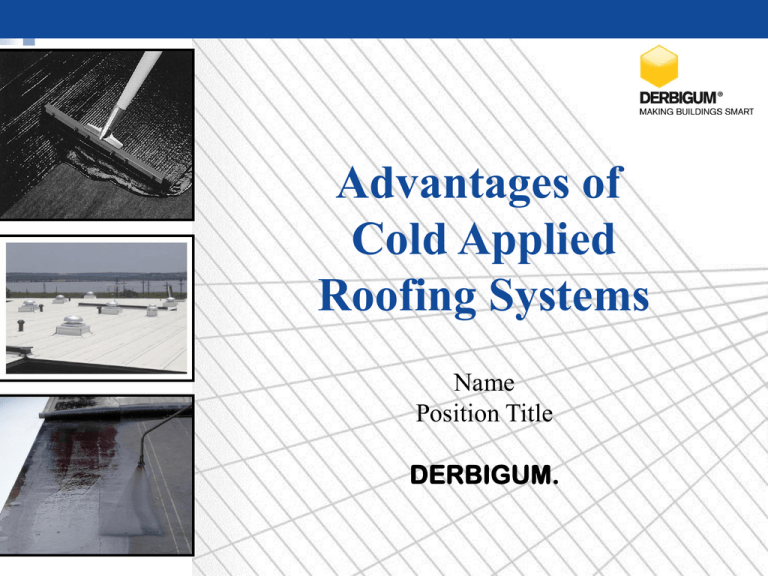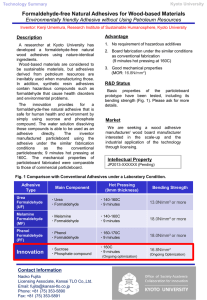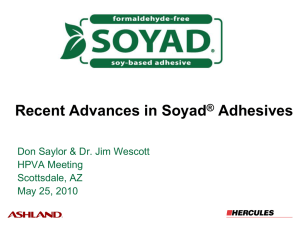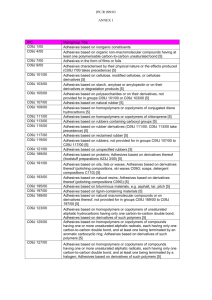Advantages of Cold Applied Roofing
advertisement

Advantages of Cold Applied Roofing Systems Name Position Title DERBIGUM. AIA/CES DERBIGUM is a Registered Provider with The American Institute of Architects Continuing Education Systems. Credit earned on completion of the program will be reported to CES Records for AIA members. Certificates of Completion for non-AIA members are available on request. AIA/CES This program is registered with the AIA/CES for continuing education. As such, it does not include content that may be deemed or construed to be an approval or endorsement by the AIA of any material of construction or any method or manner of handling, using, distributing, or dealing in any material or product. Questions related to specific materials, methods, and services will be addressed at the conclusion of this presentation. Learning Objectives Upon completion of this program, participants will be able to: Define Cold Applied Roofing Identify the key composition of Polymer Modified Cold Adhesives Recognize the types of Cold Applied Roof Systems and their advantages. Understand the application methods Acknowledge the precautions when using Cold Applied Systems What is Cold Applied Roofing? Polymer-Modified Bitumen Membranes vs. Cold Built Up Systems Alternative to: •Torch-applied systems with open flame •Hot asphalt applied systems with use of a hot kettle Traditional Hot Applied System / Oxidized Asphalt Oxidized Asphalt Introduction of oxygen to flux Benefits Increases softening point Increases utility of asphalt Problems Decreases thermal fatigue cycle Increases brittleness and breakdowns Cold Applied Roofing •Employs polymer modified adhesive in conjunction with polymer-modified bitumen membranes •Can be used with either APP or SBS systems Composition of Polymer-Modified Adhesives Asphalt Asphalt Mineral Spirits Polymers Cellulose Fibers Fillers Cellulose Fibers Fillers Base Asphalt Petroleum Asphalt the base of Cold Applied Adhesives Characteristics Black Sticky Highly Viscous is Solvents vs. Mineral Spirits Solvents Hot solvents create quicker set Toluene Xylene Mineral Spirits Mineral spirits slower set Less damage to roofing membrane Higher Flashpoint = Safer Application Polymers Types SBS APP IPP Benefits Encapsulates the light oils Increases the pliability of the bitumen Cellulose Fibers Adds reinforcement to the adhesive Provides strength to the “bonding layer” of the cold modified system Fillers Functional Increase Viscosity Adds Fire Retardant Improves UV Resistance/Weatherabilit y Thixotropy Non-Functional Add Bulk Reduces Product Cost Thixotropy Thixotrophy is a fluid that becomes less viscous under shear Ketchup is Classic Example It is thick when sitting in a jar but when you shake the bottle it breaks down and flows more easily Advantages for Cold Adhesives that are Thixotropic: Easily Spreads or Sprays More Contact with Membrane Prevents Slippage of Membrane Won’t Soak into Into Insulation/CoverBoard Holds Limestone in Suspension No Need to Stir Before Use Thixotropy Thixotropy Title/general heading 7 10 +4 6 10 +4 5 10 +4 4 10 +4 Thixotropic 3 10 +4 Viscosity cP 2 10 +4 1 10 +4 9 10 +3 8 10 +3 7 10 +3 6 10 +3 5 10 +3 1 10 -1 2 10 -1 P 25 ETC J:\2014 batches\1052017.RCO Gap 0.500 mm 5 10 -1 1 10 +0 2 10 +0 5 10 +0 1 10 +1 2 10 +1 Shear rate 1/s 5 10 +1 1 10 +2 2 10 +2 Operator 5 10 +2 0 Types of Polymer-Modified Adhesives Water-based Not good for roofing adhesion Dissolves when introduced to moisture Designed as an interior adhesive Solvent-based Withstands moisture Designed for exterior building envelope use Types of Polymer-Modified Adhesives Solvent Solvent Solids Solids High Solvent / Low Solid Toxic / High VOC Lower Softening Point Unable to walk on 55% Stays Behind High Solid / Low Solvent Low VOC Higher Softening Point User/Environmentally Friendly 82% Stays Behind Meets SCAQMD and other OTC Requirements Application Methods 5 Gallon Pails = squeegee 55 Gallon Drums = spray rig 350 Gallon Totes = spray rig Application Methods High Viscosity = Notched Squeegee Lower Viscosity = Spray Rig Application Methods Squeegee Method Uses 5 gallon pails Efficient for small areas Downside = landfill waste Application Methods 55 gallon drums Easy to transport Landfill waste Option to line drum in order to upcycle/recycle 350 gallon totes Reusable Harder to transport Climate / Temperature Considerations Cold Adhesive must be applied at: o A minimum of 65 F for squeegee application o o 100 F - 110 F for spray application Achieved with use of mastic heater Cold weather recommendations: Hot Box on Roof, Stair Tower, Elevator Room Application Considerations Mastic Thickness Too thick Damages membrane Delays cure time Too thin Improper adhesion Normal Application Rate – 2 gallons/sq. membrane to membrane 2– 2.5 gallons/sq. membrane to substrate 1.5 Application Procedure Relax Rolls Prior to Installation Prevents possible wrinkling Roofing Membranes Can Be Repositioned Prior to Adhesive Curing Lap Welding Methods •Only heat welding provides watertight application the same day −Electric hot air & roll −Torch & Roll Lap Welding Torch & Roller Lap Welding • Electric Hot Air Welder Lap Welding Lap Welding Finished Field Lap Cure Time Cure times vary dependent on: Ambient conditions Roof configurations and orientation Generally between 24 and 72 hours Watertight once laps are torched or heat welded Considerations Not all adhesives are interchangeable between APP & SBS Modified Bitumen membranes MUST have sand or liquid talc parting agent Polypropylene parting agent WILL prevent adhesion Polypropylene parting agent sheets are for TORCH USE ONLY! Considerations “peel” is more of concern than uplift during cure time Eliminate foot traffic on new membrane if a “high solvent adhesive” is used Membrane Damages membrane surface Displaces adhesive SBS more susceptible to surface damage than APP due to lower softening point Considerations Minimize odor from entering building • Stage products downwind of the building, vents and air intakes • Schedule work near air intakes when building in unoccupied • Close or cover intakes only as needed • Building Manager should communicate with building occupants Benefits of Polymer-Modified Adhesives Health & Safety Accessibility Ease of Application Handling Protection Environmental Benefits of Polymer-Modified Adhesives Health & Safety No Open Flame or Fire Risk No Kettle No Skin Burns Limited Fumes & Odor Benefits of Polymer-Modified Adhesives Accessibility In tight constrained areas on Roof-top High-rise buildings Benefits of Polymer-Modified Adhesives Ease of Application Increased Labor Productivity Smaller Crews Minimal Application Equipment Forgiving of Application Errors Clean Installation Year Round Application Benefits of Polymer-Modified Adhesives Handling Transportation Storage Handling Benefits of Polymer-Modified Adhesives Protection Redundant Ply’s Watertight Added Thickness Benefits of Polymer-Modified Adhesives Environmental Low VOC Meets SCAQMD UL/FM Approved Drive for Cold Applied • Insurance Companies • High Rise Buildings • Low odor/no smoke • No open flame • Increased productivity • LEED/RoofPoint • EPA Clean Air Act • Job site housekeeping • Additional waterproofing layers • User friendly • Application Options • Compatible with any size job QUESTIONS Thank You! __________________________ 800-727-9872 info@derbigum.us








